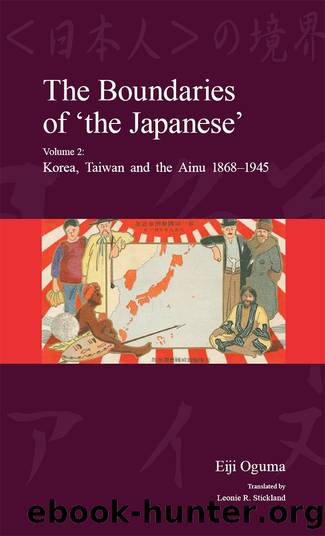The Boundaries of 'the Japanese', Volume 2 - Korea, Taiwan and the Ainu 1868-1945 by Eiji Oguma

Author:Eiji Oguma
Language: eng
Format: azw3
Publisher: Trans Pacific Press
Published: 0101-01-01T00:00:00+00:00
A desire for diversity
Around the time of the DÅkakai incident, Lin Xiandang was engaged in the establishment of private middle-schools by Taiwanese. Until then, there had only been middle-schools for Naichi-jin in Taiwan. As it was envisioned that Taiwanese children attend schools operated by Westerners in Fukien (Fujian) Province on the coast of mainland China if the establishment of middle schools were not permitted, the Government-General allowed such schools as part of a policy of gentle persuasion, but the length of the course of study was shortened due to opposition from the Legislation Bureau and Ministry of the Interior in Tokyo.
It is obvious that the series of moves around this establishment of middle schools in Taiwan demonstrated discrimination on the Japanese part, but they were also a manifestation of the demands for modern education in Korea and Taiwan which had become marked in the TaishÅ era (1912â26). The number of shufang, the traditional Taiwanese organs of education, had traced a downward trajectory since the 1898 survey, and in 1918 had shrunk to about twenty per cent of that at the commencement of surveys. As if in inverse proportion to this, the attendance rate at common schools gradually rose despite no compulsory education system having been laid down, and the attendance rate which had been a mere 6.6 per cent in 1912 had soared to 25.1 per cent in 1920 (Taiwan KyÅiku Kai 1939, pp. 408â408). In a manner of speaking, from the late 1910s into the 1920s, demands arose among Taiwanese for a shift from traditional to modern education. An almost identical phenomenon emerged somewhat belatedly in Korea, as well.
Changes occurred not only in educational, but also in cultural aspects. Moves emerged from among Taiwanese to reform the hitherto-customary foot-binding and pigtails from the standpoint of âcivilisationâ by launching the âNatural-foot Societyâ (Tennen-soku kai) (Chinese: Tianran zu hui) in 1900, and the Danpatsu fukaisÅ kai (Duan fa bu gai zhuang), an association which promoted the removal of pigtails while advocating that traditional clothing not be changed. Both foot-binding and pigtails were customs regarded by the Japanese side as âbarbarous Chinese habits,â just as Okinawan topknots had been. Japanese intellectuals had for some time advocated the reform of these customs as part of the âcivilisingâ of Taiwan, and the Government-General also welcomed such moves by the Taiwanese.
It could not be said, though, that these steps were instrumental in orienting the Taiwanese towards assimilating to âthe Japanese.â In the Okinawan case, as the route for importation of âcivilisationâ was restricted to one via naichi, it was difficult to demarcate âcivilisationâ from âJapanisationâ (see Oguma 2014, Ch. 2). In Taiwan, however, as campaigns such as for the cutting of pigtails and the cessation of foot-binding had also taken place in Mainland China, the severing of pigtails alone did not link directly with âJapanisation.â Moreover, at a later time than in Okinawa, routes such as various media and the experience of studying in naichi were also starting to take shape in regard to the influx of modern Western civilisation.
Download
This site does not store any files on its server. We only index and link to content provided by other sites. Please contact the content providers to delete copyright contents if any and email us, we'll remove relevant links or contents immediately.
| Africa | Americas |
| Arctic & Antarctica | Asia |
| Australia & Oceania | Europe |
| Middle East | Russia |
| United States | World |
| Ancient Civilizations | Military |
| Historical Study & Educational Resources |
Machine Learning at Scale with H2O by Gregory Keys | David Whiting(3693)
Never by Ken Follett(3560)
Fairy Tale by Stephen King(2994)
The Man Who Died Twice by Richard Osman(2830)
Oathbringer (The Stormlight Archive, Book 3) by Brandon Sanderson(2689)
Will by Will Smith(2610)
Rationality by Steven Pinker(2165)
The Dark Hours by Michael Connelly(2110)
The Dawn of Everything: A New History of Humanity by David Graeber & David Wengrow(2031)
Friends, Lovers, and the Big Terrible Thing by Matthew Perry(2024)
Can't Hurt Me: Master Your Mind and Defy the Odds - Clean Edition by David Goggins(2017)
Principles for Dealing With the Changing World Order: Why Nations Succeed and Fail by Ray Dalio(1915)
HBR's 10 Must Reads 2022 by Harvard Business Review(1707)
A Short History of War by Jeremy Black(1684)
Go Tell the Bees That I Am Gone by Diana Gabaldon(1606)
515945210 by Unknown(1527)
Kingdom of Ash by Maas Sarah J(1411)
443319537 by Unknown(1402)
A Game of Thrones (The Illustrated Edition) by George R. R. Martin(1385)
